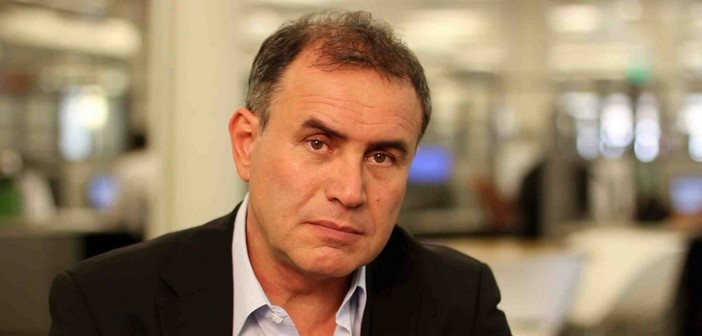Nouriel Roubini*, a professor at New York University and a world-renowned economist (he is nicknamed Dr. Doom for having predicted the housing bubble and the financial crash of 2007… Unfortunately, without being listened to!).
A highly publicized figure, he heads a think tank of specialists based in New York, London, and Singapore.
His annual forecast report is highly sought after. Many economic and political actors use it as a compass for their strategies and decisions.
For Nouriel Roubini: “It will be a year of difficulties. America is growing, but no contribution will come from the EU, China, and Japan.”
Global growth in 2015 will be slightly higher than in 2014, around 3%, but America will be the only developing region while the world economy would rather need “generalized growth to improve the living and working conditions of the population and reduce unemployment.”
“For Europe, it’s serious to have arrived in 2015 without having resolved its problems because the year that’s just started will bring a wave of elections: The first in Greece, then the presidential election in Italy, followed by parliamentary elections in Spain and Portugal, and again in Great Britain. Every election brings a lot of unknowns. What Europe will emerge from this electoral cycle?” – Nouriel Roubini further states.
But let’s see the ten summary points of the report.
1 UNITED STATES
The so-called “Anglosphere” (United States, Great Britain, Canada) will remain by far the growth area in the world.
Indeed, the only one of the four macro-zones (the others being Europe, Japan, and emerging markets including China) that will register strong growth, around 3%. “With three of the four engines stopped – Roubini writes – it’s hard to talk about ‘locomotives’: much of the economy today relies on internal demand and the Anglosphere alone is not able to create a demand by itself to trigger growth through exports in the rest of the world.”
2 CHINA
Beijing will slow down its growth further, which will be around 6% by the end of the year instead of the planned 7%. The reason is that internal reforms continue slowly, and the shift in the development model towards higher consumption has stalled.
3 EUROZONE
This is the most serious weakness on a global scale. No recovery this year – writes Mr. Roubini. Numerous political forces threaten to “break” the functioning of the euro. Roubini mentions SYRIZA and Podemos, FN, the Northern League, and M5S, while in London there is a risk on the horizon with the referendum for the EU exit. As for the ECB, even if it launches a QE plan (quantitative easing), it will be too late and too little, at least as planned (500 billion euros), to restart the economic engine and fuel the financial market.
4 OIL
It will only be towards the end of the year that producing countries will decide to cut production and prices will stabilize around $85.
Until then, values will continue to be very low, and while this is positive for Western countries, it will block the growth of emerging countries and Russia. The latter will have to find a political agreement to benefit from Western aid and avoid its economy collapsing.
5 DEFLATION
It will remain, throughout 2015, the central problem for Europe and Japan. In both regions, the growth of the price index will remain well below 1%. The collapse in oil prices will play its part.
In America, core inflation, excluding energy values and volatile food products, will be 1.6%, which is not far from the 2% target. Deflation – Roubini writes – “is a scourge with weak demand, a depressed labor market, and rising real interest rates on debt.”
6 JAPAN.
A glimmer of hope raises Abenomics 2, with its economic reforms and a strengthened QE (quantitative easing) compared to Abenomics 1. This has to be seen as the Prime Minister’s ability to trigger elections and then immediately launch coordinated monetary measures with the central bank.
For Roubini, it is “operational efficiency, coherence, and unity that Europe cannot achieve.”
7 FEDERAL RESERVE (FED).
It is estimated that US interest rates should rise in the spring, but Roubini has a different opinion: “The low rate of inflation, the strength of the dollar, the weakness of the global economy, and the slowness of wage increases due to persistent productivity problems, will likely delay this maneuver to the third quarter, if not later.”
Even for subsequent increases, planned for 2016, according to him “the Fed will avoid creating excessive expectations of a credit tightening.” The only thing that could accelerate this process would be a “releveraging” by companies if they begin to borrow too much.
8 “CURRENCY WAR.”
The simultaneous pressure from the ECB, the Bank of Japan, and China to devalue their currencies against the dollar will end up creating tensions with Washington. The forecast for exchange rates will not go beyond €1.15 and 128 yen per dollar.
9 SPECULATIVE BUBBLES.
Years of low interest rates have opened the door to speculation that can burst in credit and in the shareholder market, whose indices are at their highest. But central banks will be able to react with appropriate and innovative measures able to avoid any influence on monetary policy.
10 VOLATILITY OF FINANCIAL MARKETS
The importance of the money supply in circulation could cause a short-circuit in the markets in the event of a very significant political shock, positive or negative, in Europe.
Conclusion: a forecast is merely an event that has a higher probability of occurring instead of another. It should never be taken as a proclaimed truth.
But there are those who are better equipped than others, with more experienced and effective analysis models.
It is at the end of the year that has just begun that we will know if, as some colleagues call him, the “Prophet” will have lived up to his reputation.


